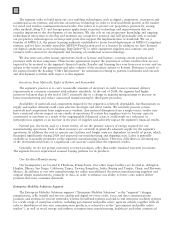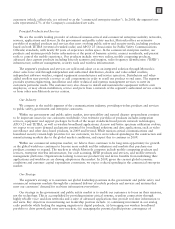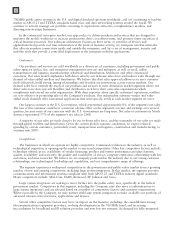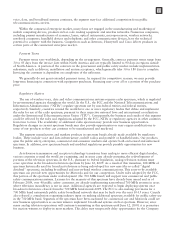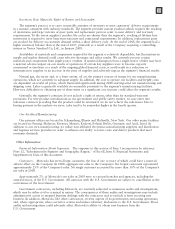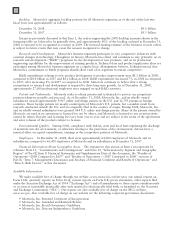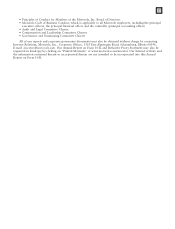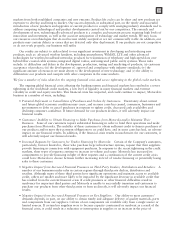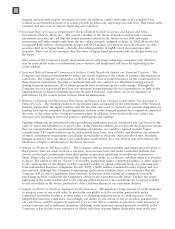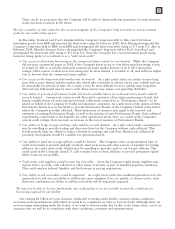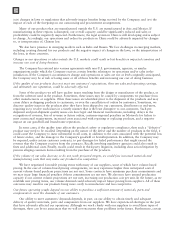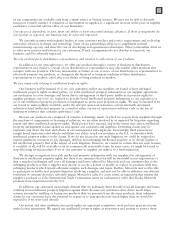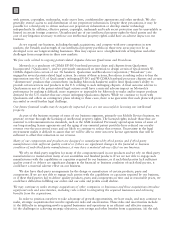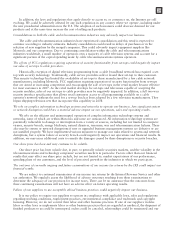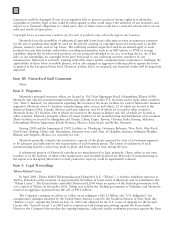Motorola 2008 Annual Report Download - page 28
Download and view the complete annual report
Please find page 28 of the 2008 Motorola annual report below. You can navigate through the pages in the report by either clicking on the pages listed below, or by using the keyword search tool below to find specific information within the annual report.
supplies and adversely impact our financial results. In addition, credit constraints at key suppliers have
resulted in accelerated payment of accounts payable by Motorola, impacting our cash flow. This trend could
continue and may even accelerate, impacting our cash flow.
•Increased Risk of Losses or Impairment Charges Related to Debt Securities and Equity and Other
Investments Held by Motorola: The current volatility in the financial markets and overall economic
uncertainty increases the risk that the actual amounts realized in the future on our debt and equity
investments will differ significantly from the fair values currently assigned to them. In 2008, Motorola has
recognized $186 million of impairment charges and $101 million of temporary unrealized losses on debt
securities held in its Sigma Fund, a broadly diversified portfolio of highly rated, short-duration debt
securities. There can be no assurance that the value of Sigma Fund investments will not decline further in
the future.
Also, many of the Company’s equity investments are in early-stage technology companies and, therefore,
may be particularly subject to substantial price volatility and heightened risk from the tightening in the
credit markets.
•Increased Risk of Financial Counterparty Failures Could Negatively Impact our Financial Position: The
Company uses financial instruments to reduce its overall exposure to the effects of currency fluctuations on
cash flows. The Company is exposed to credit loss in the event of nonperformance by the counterparties to
these financial instruments. In order to minimize this risk, the contracts are distributed among several
leading financial institutions, all of whom presently have investment grade credit ratings. Although the
Company has not experienced and does not anticipate nonperformance by its counterparties, in light of the
ongoing threats to financial institutions from the global financial crisis, there can be no assurance of
performance by the counterparties to these financial instruments.
•Returns on Pension and Retirement Plan Assets and Interest Rate Changes Could Affect Our Earnings in
Future Periods: The funding position of our pension plans is impacted by the performance of the financial
markets, particularly the equity markets, and the discount rates used to calculate our pension obligations for
funding and expense purposes. Recent significant declines in the financial markets have negatively impacted
the value of the assets in the Company’s pension plans. In addition, lower bond yields may reduce our
discount rates resulting in increased pension contributions and expense.
Funding obligations are determined under government regulations and are measured each year based on the
value of assets and liabilities on a specific date. If the financial markets do not provide the long-term returns
that are expected under the governmental funding calculations, we could be required to make larger
contributions. The equity markets can be, and recently have been, very volatile, and therefore our estimate
of future contribution requirements can change dramatically in relatively short periods of time. Similarly,
changes in interest rates can impact our contribution requirements. In a low interest rate environment, the
likelihood of higher contributions in the future increases.
•Impact on Ability to Sell Receivables: The Company sells accounts receivable and long-term receivables to
third parties. Sales are made both on a one-time, non-recourse basis and under committed facilities that
involve contractual commitments from third parties to purchase qualifying receivables up to monetary
limits. These sales of receivables provide the Company the ability to accelerate cash flow when it is prudent
to do so. The ability to sell (or “factor”) receivables, particularly under committed facilities, is often subject
to the credit quality of the obligor and the Company’s ability to obtain sufficient levels of credit insurance
from independent insurance companies. In early 2009, a $400 million committed facility expired and was
not renewed. Although the Company is negotiating replacement facilities, there is no assurance that the
Company will be able to implement these facilities. Reduction in the volume of committed receivable
purchasing facilities could limit the Company’s ability to sell receivables in the future. Further, the severe
tightening in the credit markets due to the ongoing global financial crisis could limit the Company’s ability
to sell receivables in the future, particularly if the creditworthiness of our customers declines.
•Impact on Ability to Purchase Sufficient Credit Insurance: We purchase a large amount of credit insurance
to mitigate some of our credit risks. In particular, our ability to sell receivables, particularly under
committed receivables facilities, is often subject to obtaining sufficient levels of credit insurance from
independent insurance companies. Accordingly, our ability to sell certain of our receivables, and therefore
our cash flows, could be negatively impacted if we are not able to continue to purchase credit insurance in
certain countries and in sufficient quantities. Although credit insurance remains generally available to the
Company, it has become more expensive to obtain and often requires higher deductibles than in the past.
20


